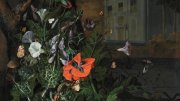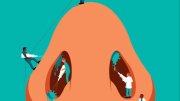 |
| "Your wooden arm you hold outstretched to shake with passers-by." |
Watching President George W. Bush at the podium, one might judge that in the elocutionary arts, he falls down in the gesture department. A tentative finger-point. A drift of the open hand. He might do well to study A Practical Treatise of Gesture (1829), by Jonathan Barber, who taught elocution at Harvard from 1829 to 1834 and was said by one observer to be zealous about it, although "pompous and fantastic in mien, speech, and manners."
Michael West '59, professor of English at the University of Pittsburgh, writes in Transcendental Wordplay: America's Romantic Punsters and the Search for the Language of Nature that Barber initiated students into the mysteries of rhetorical gesture with an apparatus like a bamboo cage that he devised. "The student stood inside four equal vertical hoops, each angled at 45 degrees from the others. Around these meridians ran three horizontal great circles, so seven hoops encircled a student. Constituting a hollow globe over six feet in diameter, the hoops divided its surface into 32 different apertures. The student could thrust his hands into various openings in front of him. The postures so defined corresponded to '15 fundamental or systematic positions' that the orator's arms might assume while speaking, each associated by Barber with a specific emotion....To master eloquence, all Harvard students were marched into this bathosphere and required to declaim under his watchful eye, thrusting their hands through designated slats at appropriate points in the text.
"More beloved by its inventor than by its victims," writes West, "the bamboo sphere was found one morning dangling from a Cambridge barber pole."

Organized crime: Branding Division. Tony Soprano would know—and contributing editor Edward Tenner, Jf '72, points out—that Al Capone got his start at a Coney Island tavern called the Harvard Inn, so named by its proprietor, the eminent gangster Frankie Yale. The 18-year-old Capone's job was to be the bartender and bouncer and to wait on tables if necessary.
 |
| Frankie Yale |
| Chicago Historical Society / ICH1-23877 |
Capone did well in his work at first, until one day he waited on the table of a young couple. "The girl was beautiful and the young Capone was entranced," writes Marilyn Bardsley of the on-line Crime Library. He leaned over the girl and miscommunicated—in effect if not intent. "Honey," said Capone, "you have a nice ass, and I mean that as a compliment."
The man with her was Frank Gallucio, her brother. He leapt to his feet and punched Capone, who "flew into a rage." Gallucio pulled a knife to defend himself and cut Capone's face three times before grabbing his sister and fleeing. Gallucio took his grievance to Lucky Luciano, who went to Yale. The three of them persuaded Capone to apologize. His physical wounds healed, but he was known thereafter, in some circles, as "Scarface."
Tenner suggests that the menacing Frankie Yale missed an even better name for his tavern: "The Skull and Bones."

Cupid in the kitchen. With Valentine's Day approaching, consider saying it with food. Sarah Hutcheon of the Radcliffe Institute's Schlesinger Library provides a reading list of lubricious cookbooks from its culinary collection: Robert Hendrickson, Foods for Love: The Complete Guide to Aphrodisiac Edibles (1974); Janeen Sarlin, Fifty Ways to Feed Your Lover (2000); Judith Stewart, The Passionate Gourmet (1990); Susan Hartz, The Great Lovers Cookbook (1984); Ernest Carteris, A Cookbook for Lovers (1970); Cynthia Watson, Love Potions: A Guide to Aphrodisia and Sexual Pleasures (1993); Raymond Stark, The Book of Aphrodisiacs (1981); Barbara Cartland, The Romance of Food (1984); and Omero Rompini, La cucina dell'amore: Manuale culinario afrodisiaco per gli adulti dei due sessi Rigenerazione fisica, virilità e giovinezza ricuperate per l'impiego appropriato dei cibi, condimenti, aromi, salse ecc. Formule storiche, afrodisiaci igienici prodigiosi, bibite e profumi eccitanti, suggestivi e rinvigoritori sessuali (1926).





